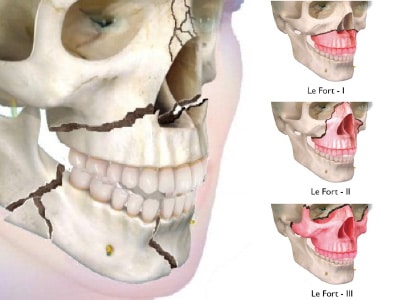
July 7, 2022
Le Fort Fracture – Maxillofacial Surgery Lloyd|dr alfredo zuiko, le fort fracture, Maxillofacial Surgery Lima Peru
Mandibular fracture is one of the most common and dangerous facial injuries. There are a number of treatments that can be used to cure this, one of them is the open reduction of ‘Le Fort’ fracture.
The jaw is a bone that performs important functions such as speaking, eating, and breathing. Therefore, when this fracture occurs, it should be treated immediately. Otherwise, it could have serious consequences.
WHAT IS A LE FORT FRACTURE?
It is a fracture produced in the middle third of the face and affects various bony components of the facial skeleton. René Le Fort was the one who studied this type of fractures and classified them into three degrees of severity.
Le Fort I fracture: is a horizontal fracture that takes place in the upper jaw. Essentially, it’s a separation of the hard palate from the upper maxilla due to a transverse fracture running through the maxilla and pterygoid plates at a level just above the floor of the nose.
Le Fort II fracture: it is a pyramidal fracture, larger than level one. It not only includes the upper jaw, but also the front-nasal junction, nasal root, and pterygoid process.
Le Fort III fracture: Level III is the most extensive as it can result in a complete dislocation of the midface from the base of the skull, known as a craniofacial dislocation.
WHAT IS A LE FORT OPEN REDUCTION?
There are several procedures to treat a Le Fort fracture. The treatment chosen will depend on the severity of the fracture.
For example, in case of a very minor fracture, then a soft diet or bandage may be recommended while the bone heals naturally. However, if it is a more serious fracture, a Le Fort open reduction is recommended.
Le Fort open reduction involves joining the bones together again through surgery. To do this, special devices will be used, which will hold the pieces of bone until they can be put back into place.
HOW IS IT PERFORMED?
First, it is important to perform a physical examination. Our specialist in maxillofacial surgery, Dr. Alfredo Zuiko, will perform certain tests to find out if there is a fracture and if so, its extent. In addition, he will perform 3D x-rays to achieve a complete study of the bone structure.

Dr Alfredo Zuiko, specialist in maxillofacial surgery
He begins by anesthetizing the area and you will be under general anesthesia, asleep, and completely comfortable. Then, a small incision is made. Titanium plates and screws are applied that will allow the fractured bones to be fixed in place.
Finally, the healing process will take approximately six weeks, depending on the severity of the case. However, these plates and screws will be used by the patient throughout his life and remain in place.
WHAT ARE THE MAIN CAUSES?
- Car accidents.
- Industrial accidents.
- Physical aggression.
- Blows to the head when playing sports, such as football or hockey.
- A bad tooth extraction.
In conclusion, these fractures can be caused by any blow or fall that is severe enough to cause damage to the facial bone strcuture.
SIGNS I NEED A LE FORT OPEN FRACTURE SURGERY
When a person suffers this type of fracture, the patient will present certain symptoms such as:
- Bruising, swelling and/or numbness in the face.
- Severe pain, especially when biting or chewing food.
- Jaw stiffness.
- Bleeding in the mouth.
- Loose or damaged teeth.
If you have any of these symptoms, it is important that you see a specialist doctor soon.
SCHEDULE A CONSULTATION
Maxillofacial surgery is complex and requires special analysis. If you think you need a mandibular distraction surgery, please contact us.
We are also on WhatsApp for additional information or to schedule an appointment.



Comments
Sorry no comment yet.